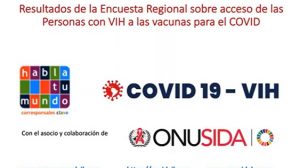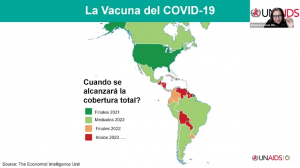As in the old days of funding by Rounds, the Global Fund to Fight AIDS, Tuberculosis and Malaria (Global Fund) toured the developing world to explain the features of the New Funding Model (NFM). The first week of April was the turn of Latin America, and the second was the Caribbean´s turn with a similar meeting in Kingston, Jamaica.
 After nearly two years’ development, the NFM is under full implementation and the countries have started the complex processes to apply for funding. The NFM has been explained in recent Key Correspondent articles. In addition, the Fund has published a leaflet, an explanatory video (see link) and a document with ten FAQs which can be downloaded from this link.
After nearly two years’ development, the NFM is under full implementation and the countries have started the complex processes to apply for funding. The NFM has been explained in recent Key Correspondent articles. In addition, the Fund has published a leaflet, an explanatory video (see link) and a document with ten FAQs which can be downloaded from this link.
The Quito meeting had a very distinctive character, with a growing governmental leadership, as seen in the presence of some Ministers and Deputy Ministers of health-related areas from participating countries, as well as representatives of ministries of economy and finance. This participation is not only important from the point of view of national ownership of the Global Fund´s programs, but also from the point of view of understanding the counterpart funding model and the willingness-to-pay that countries must state when applying for NFM resources.
Understanding the Model
The workshop focused on the introduction of the NFM: the processes and steps to be followed by countries, as well as allocations, willingness-to-pay and new criteria that must be met by CCMs. The following aspects should be highlighted:
National Strategic Plan: This is the first step in the funding application process of the NFM. Applicant countries are expected to have reviewed and validated their National Strategic Plan for AIDS, tuberculosis or malaria, as appropriate. These plans should be budgeted and must have passed such checking and validation mechanisms as the Joint Assessment of National Health Strategies (JANS). Countries should provide information on NASA studies, population sizes and modes of transmission, among others. The NFM is based on a quality, updated and valid national strategic plans which are the result of a participative process that involves all sectors related to the response. Thus, the National Strategy is drafted as an assumption or an investment case for the diseases in each country, to be funded by national budgets with local resources, the Global Fund -with the NFM-, and other external donors.
 Better Country Coordinating Mechanisms: In the NFM, the CCMs shall self-assess the minimum eligibility criteria and shall submit a development plan to improve and meet such criteria. The Global Fund and the International HIV/AIDS Alliance have developed a CCM self-evaluation tool and have trained a dozen consultants in the region who are now working with the Mechanisms.
Better Country Coordinating Mechanisms: In the NFM, the CCMs shall self-assess the minimum eligibility criteria and shall submit a development plan to improve and meet such criteria. The Global Fund and the International HIV/AIDS Alliance have developed a CCM self-evaluation tool and have trained a dozen consultants in the region who are now working with the Mechanisms.
CCM eligibility requirements are not new, they have also been improved with the NFM, so it is always worth reviewing them: 1) A transparent and inclusive Concept Note development process 2) An open and transparent Principal Recipient selection process, 3) Strategic oversight planning and implementation, 4) Involvement of affected communities in CCM, including representatives of communities living with and affected by these three diseases, 5) Processes for electing non-government CCM members, 6) Management of conflict of interest. Criteria 1 and 2 are mandatory when submitting the concept note while the others must be reported on a yearly basis. As from January 2015 all the requirements will be mandatory and non-compliance may lead to a program being discontinued.
The Country Dialogue Process: As soon as the National Strategic Plan review and validation start, a Country Dialogue process begins. This process must continue throughout the NFM process. When we refer to a National Dialogue, we mean a permanent consultation process that is more inclusive than the CCMs, where all sectors involved in the response, whether by disease, population or country/ region, have the chance to contribute to the proposal development and review. A recent experience in El Salvador, a country that tested the NFM in its interim phase, showed the feasibility of a comprehensive dialogue in which different consultations by population and by intervention type helped nurture the concept note.
 In the New Model, the country teams of the Global Fund Secretariat participate more directly in the processes, with regular visits and technical support. The Global Fund includes financial support for national or regional dialogue (the latter in the case of regional proposals).
In the New Model, the country teams of the Global Fund Secretariat participate more directly in the processes, with regular visits and technical support. The Global Fund includes financial support for national or regional dialogue (the latter in the case of regional proposals).
Concept Note: This document is submitted by the CCM to the Global Fund. It replaces the former applications and must be based on National strategic Plans and investment cases.
The concept note includes the following sections: (a) Country context, (b) Funding “landscape” (including additionality and sustainability), (c) Funding request, (d) Implementation arrangements and (e) Risk analysis.
Regional proposals: As reported previously (see link), the Global Fund has reviewed the application process for regional proposals. A special briefing session was held at the Quito meeting regarding the application process for regional and multi-country projects. It is important to remember that the first step in this process is to submit an Expression of Interest to the Global Fund, for which the 2014 deadline is May 1 (the deadline for next year is estimated to be in April). The Board approved a total of 200 million dollars for the next two years, so strong competition is expected among regional proposals for the 100 million dollars available in the current year. More information is available through this link.
Impact and sustainability
The New Funding Model is not only a new way to apply for funding but also a new approach to the co-responsibility of implementing countries expressed in:
Counterpart Financing: This refers to all public and domestic resources allocated to the response to the three diseases, including those allocated to the health sector in general. These funds may come from tax income, local health insurance systems, international loans and debt swap mechanisms.
 The counterpart-financing threshold is set at 5% for LICs, 20% for Lower LMICs, 40% for Upper LMICs, and 60% for UMICs. The increase of additional government contributions to the three disease programs and to the health sector will be measured in absolute terms. In addition to the real allocation of resources this will require an improvement in the measurement of health spending and spending per disease. In order to improve these national accounts the Global Fund will invest up to a maximum of 50,000 dollars per country.
The counterpart-financing threshold is set at 5% for LICs, 20% for Lower LMICs, 40% for Upper LMICs, and 60% for UMICs. The increase of additional government contributions to the three disease programs and to the health sector will be measured in absolute terms. In addition to the real allocation of resources this will require an improvement in the measurement of health spending and spending per disease. In order to improve these national accounts the Global Fund will invest up to a maximum of 50,000 dollars per country.
Willingness-to-pay (WTP): Out of the resources allocated per country and per disease, which have been reported publicly, the Global Fund will retain 15% under the “willingness-to-pay” policy. This amount will be available once the government has verifiably increased its absolute investment in the disease and committed to the strategic areas of ongoing programs. These commitments will be detailed in the concept note.
The increase in verifiable counterpart funding and compliance with WTP will be -in three or four years’ time- an indicator that our governments are taking on the long-term sustainability of the response to the diseases. However, approaches to political and financial sustainability are somewhat more complex than the Global Fund’s policy and requires further specific analysis.
 Greater focus for greater impact: The NFM process in El Salvador has shown that in the country Dialogues and as a result of the coexistence of diverse interests and needs, the Global Fund will not always provide funding to meet expectations. Our partners in El Salvador have referred to the “letter to Santa Claus” as an example of how at a given time in the national dialogue a list of requests had been drawn up by everyone and for everyone. Active participation of the Global Fund Secretariat was key to moderate these expectations and re-focus the concept note. To continue with the same example, the Global Fund demanded that 50% of funds requested be concentrated on interventions in key populations, a suggestion that the country eventually accepted. And this will be the trend for countries in our region, mostly medium-income economies with HIV epidemics concentrated in men who have sex with men, trans people, and sex workers. In addition, the Global Fund will demand interventions of greater impact and efficiency to better reach more of these high-risk populations. The NFM will demand a greater (evidence-based) approach and impact. For other areas, funds from other sources will have to be used.
Greater focus for greater impact: The NFM process in El Salvador has shown that in the country Dialogues and as a result of the coexistence of diverse interests and needs, the Global Fund will not always provide funding to meet expectations. Our partners in El Salvador have referred to the “letter to Santa Claus” as an example of how at a given time in the national dialogue a list of requests had been drawn up by everyone and for everyone. Active participation of the Global Fund Secretariat was key to moderate these expectations and re-focus the concept note. To continue with the same example, the Global Fund demanded that 50% of funds requested be concentrated on interventions in key populations, a suggestion that the country eventually accepted. And this will be the trend for countries in our region, mostly medium-income economies with HIV epidemics concentrated in men who have sex with men, trans people, and sex workers. In addition, the Global Fund will demand interventions of greater impact and efficiency to better reach more of these high-risk populations. The NFM will demand a greater (evidence-based) approach and impact. For other areas, funds from other sources will have to be used.
In this article we have sought to cover most of the content and issues discussed, in order to ensure that those who have not participated in the meeting can still get the information. In each link in this article there is more summary, clear and user-friendly information, you only need to read it.












Añadir comentario